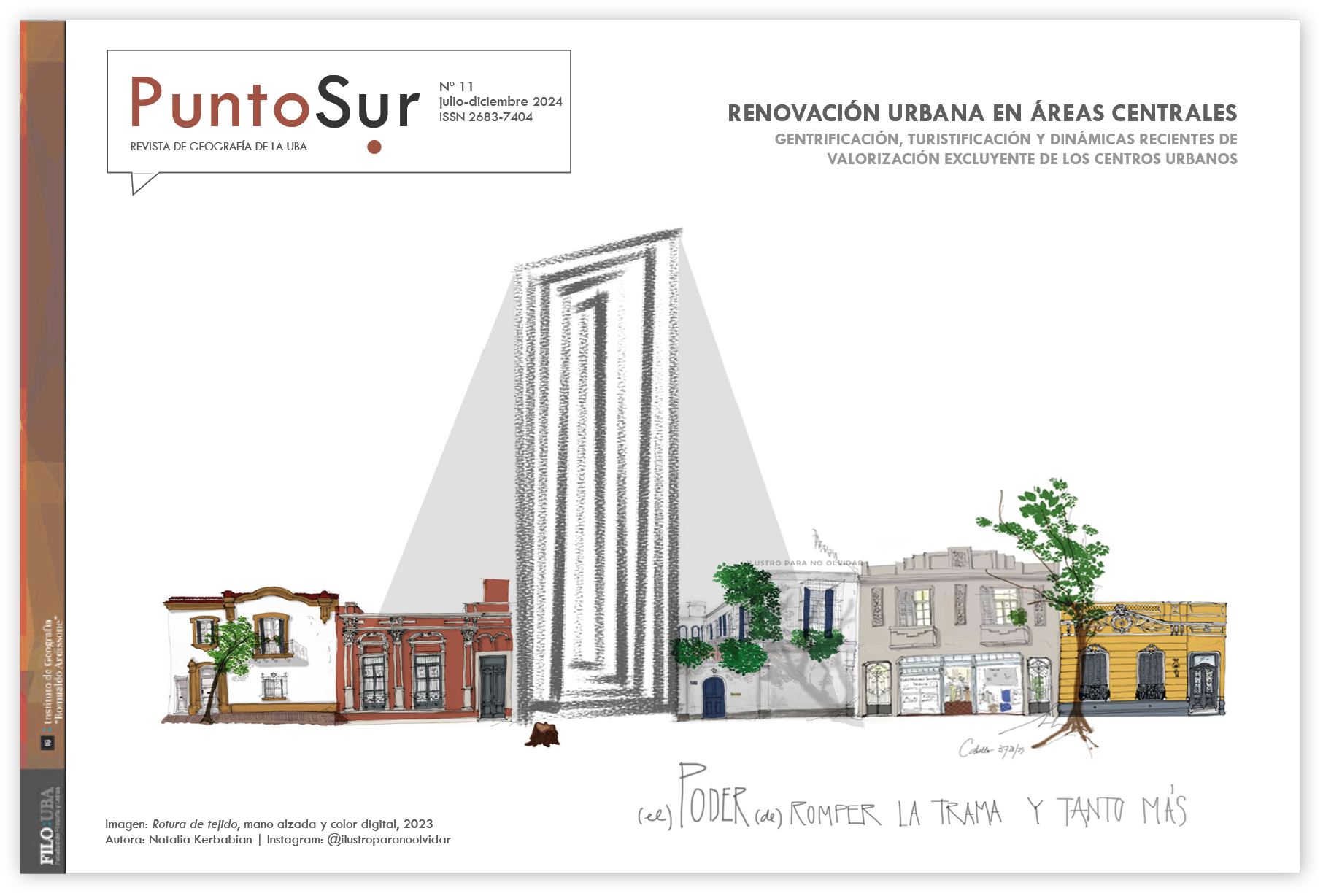Infraestructuras y paradigmas tecnoeconómicos en la Región Pampeana de Argentina
Un estudio de la selectividad estatal y la estructuración socioespacial
Palabras clave:
INFRAESTRUCTURAS, PATRONES ESPACIALES, SELECTIVIDAD ESTATAL, ESTRUCTURACIÓN ESPACIAL, PARADIGMAS TECNO-ECONÓMICOS
Resumen
El palimpsesto de infraestructuras que caracteriza a los territorios contemporáneos refleja los ciclos históricos de valorización del capital a través de la inversión en nueva tecnología. Sin embargo, se trata de un paisaje opaco. Aún desconocemos los patrones de difusión de estas tecnologías y, más aún, su carácter desigual e incompleto. Mediante una investigación exploratoria, este artículo caracteriza las diferentes capas geológicas de las infraestructuras que configuran la región pampeana argentina, con el fin de evidenciar el proceso de selectividad que el Estado y el capital global despliegan frente a las crisis de acumulación y la emergencia de cada paradigma tecnoeconómico.Descargas
La descarga de datos todavía no está disponible.
Citas
Appel, H., Anand, N., & Gupta, A. (2013). Temporality, politics, and the promise of infrastructure. Durham, NC: Duke University Press. https://doi.org/10.1215/9780822378563
Baladrón, M. (2019). El Plan "Argentina Conectada": Una política de Estado desde la infraestructura de comunicaciones. Ciencia, Tecnología y Política, 2(2), 017-017. https://doi.org/10.24215/26182859e017
Batty, M. (2013). The new science of cities. Cambridge, MA: The MIT Press. https://mitpress.mit.edu/9780262019521/the-new-science-of-cities/
Brenner, N. (2003). Glocalization as a state spatial strategy: Urban entrepreneurialism and the new politics of uneven development in Western Europe. In J. Peck & H. Wai-chung Yeung (Eds.), Remaking the global economy: Economic-geographical perspectives (pp. 197–215). London, Thousand Oaks, CA: SAGE. https://doi.org/10.4135/9781446216437.n12
Corboz, A. (1983). Le territoire comme palimpseste. Diogène, 121, 14–35. https://doi.org/10.3917/dio.121.0014
Cox, K. (1990). Territorial structures of the state: Some conceptual issues. Tijdschrift Voor Economische en Sociale Geografie, 81(4), 251–266. https://doi.org/10.1111/j.1467-9663.1990.tb01617.x
Chesnais, F. (2003). La teoría del régimen de acumulación financiarizado: Contenido, alcance e interrogantes. Revista de Economía Crítica, 1, 37-72. http://revistaeconomiacritica.org/sites/default/files/revistas/n1/02_Chesnais.pdf
Dematteis, G. (1995). Progetto implicito: Il contributo della geografia umana alle scienze del territorio. Milano: Franco Angeli. https://www.francoangeli.it/Ricerca/scheda_libro.aspx?ID=567
Dosi, G. (1982). Technological paradigms and technological trajectories: A suggested interpretation of determinants and directions of technical change. Research Policy, 11(3), 147-162. https://doi.org/10.1016/0048-7333(82)90016-6
Dupuy, G. (1998). El urbanismo de las redes: Teorías y métodos. Barcelona: Colegio de Ingenieros de Caminos, Canales y Puertos. https://www.ciccp.es/servicios/publicaciones/el-urbanismo-de-las-redes
Easterling, K. (2014). Extrastatecraft: The power of infrastructure space. London: Verso Books. https://www.versobooks.com/books/1892-extrastatecraft
Edwards, P. N. (2003). Infrastructure and modernity: Force, time, and social organization in the history of sociotechnical systems. In T. J. Misa, P. Brey, & A. Feenberg (Eds.), Modernity and technology (pp. 185–226). Cambridge, MA: MIT Press. https://mitpress.mit.edu/9780262633390/modernity-and-technology/
Elinbaum, P. (2023). Representaciones escalares de las infraestructuras portuarias: Urbanización, innovación tecnológica y división internacional del trabajo. 2º Jornadas CEUR: Espacio, tecnología y acumulación: los senderos del desarrollo y sus límites, 26-28 de julio de 2023, Buenos Aires, Argentina. http://ceur-conicet.gov.ar/jornadas-2023/
Erol-Kantarci, M., & Mouftah, H. T. (2011). Wireless sensor networks for cost-efficient residential energy management in the smart grid. IEEE Transactions on Smart Grid, 2(2), 314-325. https://doi.org/10.1109/TSG.2011.2114678
Etingoff, K. (Ed.). (2015). Urban ecology: Strategies for green infrastructure and land use. Boca Raton, FL: Apple Academic Press. https://www.routledge.com/Urban-Ecology-Strategies-for-Green-Infrastructure-and-Land-Use/Etingoff/p/book/9781771882825
Freeman, C., & Pérez, C. (1988). Structural crises of adjustment: Business cycles and investment behaviour. In G. Dosi, C. Freeman, R. Nelson, G. Silverberg, & L. Soete (Eds.), Technical change and economic theory (pp. 38-66). London: Pinter Publishers. https://www.routledge.com/Technical-Change-and-Economic-Theory/Dosi-Freeman-Nelson-Silverberg-Soete/p/book/9780861879282
Gandelsonas, M. (1998). The city as the object of architecture. Assemblage, 37, 128–144. https://www.jstor.org/stable/3171344
García, D. (1976). El desarrollo portuario argentino (Tesis doctoral, Universidad de Buenos Aires, Facultad de Ciencias Económicas). https://repositorio.uba.ar/handle/123456789/1928
Graham, S., & Marvin, S. (2001). Splintering urbanism: Networked infrastructures, technological mobilities and the urban condition. New York, NY: Routledge. https://doi.org/10.4324/9780203452202
Harvey, D. (1990). Los límites del capitalismo y la teoría marxista. Ciudad de México: Fondo de Cultura Económica. https://libreria.fondodeculturaeconomica.com.mx/products/los-limites-del-capitalismo-y-la-teoria-marxista
Herce, M. (2013). El negocio del territorio: Evolución y perspectivas de la ciudad moderna. Madrid: Alianza. https://alianzaeditorial.es/libro/alianza-ensayo/el-negocio-del-territorio-manel-herce-9788420672106/
Jessop, B. (1990). State theory: Putting the capitalist state in its place. University Park, PA: Pennsylvania State University Press. https://www.psupress.org/books/titles/0-271-00783-4.html
Jessop, B., Brenner, N., & Jones, M. (2008). Theorizing sociospatial relations. Environment and Planning D: Society and Space, 26(3), 389–401. https://doi.org/10.1068/d9107
Mandel, E. (1980). Long waves of capitalist development: A Marxist interpretation. Cambridge: Cambridge University Press. https://doi.org/10.1017/CBO9781139171280
Massey, D. (1985). New directions in space. In D. Gregory & J. Urry (Eds.), Social relations and spatial structures (pp. 9–19). London: Macmillan Education UK. https://link.springer.com/chapter/10.1007/978-1-349-27935-6_2
Massey, D. (1995). Spatial divisions of labour: Social structures and the geography of production. London: Palgrave. https://doi.org/10.1007/978-1-349-24186-5
Ngai, P., & Peier, C. (2022). Confronting global infrastructural capitalism: The triple logic of the 'vanguard' and its inevitable spatial and class contradictions in China's high-speed rail program. Cultural Studies, 37(6), 872-893. https://doi.org/10.1080/09502386.2022.2109457
Paterson, M. (2000). Car culture and global environmental politics. Review of International Studies, 26(2), 253-270. https://doi.org/10.1017/S0260210500002538
Perez, C. (1985). Microelectronics, long waves and world structural change: New perspectives for developing countries. World Development, 13(3), 441-463. https://doi.org/10.1016/0305-750X(85)90141-2
Perez, C. (2010). Technological revolutions and techno-economic paradigms. Cambridge Journal of Economics, 34(1), 185-202. https://doi.org/10.1093/cje/bep051
Rieznik, M. (2013). Dibujando con alambres la espaciotemporalidad en la Argentina del siglo XIX: Los esquemas de tendidos telegráficos diagramados por Manuel Bahía (1891). In A. Catálogo (Ed.), Geografía y cultura visual: Los usos de las imágenes en las reflexiones sobre el espacio (pp. 351-367). Rosario: Prohistoria. http://www.prohistoria.com.ar/libros/detalleLibro.php?bookId=142
Secchi, B. (1992). Urbanistica descrittiva. Casabella, 588, 22–23. https://www.casabellaweb.eu/1992/07/21/casabella-588/
Wellman, K., & Spiller, M. (2012). Urban infrastructure: Finance and management. Hoboken, NJ: Wiley. https://www.wiley.com/en-us/Urban+Infrastructure%3A+Finance+and+Management-p-9781118174237
Baladrón, M. (2019). El Plan "Argentina Conectada": Una política de Estado desde la infraestructura de comunicaciones. Ciencia, Tecnología y Política, 2(2), 017-017. https://doi.org/10.24215/26182859e017
Batty, M. (2013). The new science of cities. Cambridge, MA: The MIT Press. https://mitpress.mit.edu/9780262019521/the-new-science-of-cities/
Brenner, N. (2003). Glocalization as a state spatial strategy: Urban entrepreneurialism and the new politics of uneven development in Western Europe. In J. Peck & H. Wai-chung Yeung (Eds.), Remaking the global economy: Economic-geographical perspectives (pp. 197–215). London, Thousand Oaks, CA: SAGE. https://doi.org/10.4135/9781446216437.n12
Corboz, A. (1983). Le territoire comme palimpseste. Diogène, 121, 14–35. https://doi.org/10.3917/dio.121.0014
Cox, K. (1990). Territorial structures of the state: Some conceptual issues. Tijdschrift Voor Economische en Sociale Geografie, 81(4), 251–266. https://doi.org/10.1111/j.1467-9663.1990.tb01617.x
Chesnais, F. (2003). La teoría del régimen de acumulación financiarizado: Contenido, alcance e interrogantes. Revista de Economía Crítica, 1, 37-72. http://revistaeconomiacritica.org/sites/default/files/revistas/n1/02_Chesnais.pdf
Dematteis, G. (1995). Progetto implicito: Il contributo della geografia umana alle scienze del territorio. Milano: Franco Angeli. https://www.francoangeli.it/Ricerca/scheda_libro.aspx?ID=567
Dosi, G. (1982). Technological paradigms and technological trajectories: A suggested interpretation of determinants and directions of technical change. Research Policy, 11(3), 147-162. https://doi.org/10.1016/0048-7333(82)90016-6
Dupuy, G. (1998). El urbanismo de las redes: Teorías y métodos. Barcelona: Colegio de Ingenieros de Caminos, Canales y Puertos. https://www.ciccp.es/servicios/publicaciones/el-urbanismo-de-las-redes
Easterling, K. (2014). Extrastatecraft: The power of infrastructure space. London: Verso Books. https://www.versobooks.com/books/1892-extrastatecraft
Edwards, P. N. (2003). Infrastructure and modernity: Force, time, and social organization in the history of sociotechnical systems. In T. J. Misa, P. Brey, & A. Feenberg (Eds.), Modernity and technology (pp. 185–226). Cambridge, MA: MIT Press. https://mitpress.mit.edu/9780262633390/modernity-and-technology/
Elinbaum, P. (2023). Representaciones escalares de las infraestructuras portuarias: Urbanización, innovación tecnológica y división internacional del trabajo. 2º Jornadas CEUR: Espacio, tecnología y acumulación: los senderos del desarrollo y sus límites, 26-28 de julio de 2023, Buenos Aires, Argentina. http://ceur-conicet.gov.ar/jornadas-2023/
Erol-Kantarci, M., & Mouftah, H. T. (2011). Wireless sensor networks for cost-efficient residential energy management in the smart grid. IEEE Transactions on Smart Grid, 2(2), 314-325. https://doi.org/10.1109/TSG.2011.2114678
Etingoff, K. (Ed.). (2015). Urban ecology: Strategies for green infrastructure and land use. Boca Raton, FL: Apple Academic Press. https://www.routledge.com/Urban-Ecology-Strategies-for-Green-Infrastructure-and-Land-Use/Etingoff/p/book/9781771882825
Freeman, C., & Pérez, C. (1988). Structural crises of adjustment: Business cycles and investment behaviour. In G. Dosi, C. Freeman, R. Nelson, G. Silverberg, & L. Soete (Eds.), Technical change and economic theory (pp. 38-66). London: Pinter Publishers. https://www.routledge.com/Technical-Change-and-Economic-Theory/Dosi-Freeman-Nelson-Silverberg-Soete/p/book/9780861879282
Gandelsonas, M. (1998). The city as the object of architecture. Assemblage, 37, 128–144. https://www.jstor.org/stable/3171344
García, D. (1976). El desarrollo portuario argentino (Tesis doctoral, Universidad de Buenos Aires, Facultad de Ciencias Económicas). https://repositorio.uba.ar/handle/123456789/1928
Graham, S., & Marvin, S. (2001). Splintering urbanism: Networked infrastructures, technological mobilities and the urban condition. New York, NY: Routledge. https://doi.org/10.4324/9780203452202
Harvey, D. (1990). Los límites del capitalismo y la teoría marxista. Ciudad de México: Fondo de Cultura Económica. https://libreria.fondodeculturaeconomica.com.mx/products/los-limites-del-capitalismo-y-la-teoria-marxista
Herce, M. (2013). El negocio del territorio: Evolución y perspectivas de la ciudad moderna. Madrid: Alianza. https://alianzaeditorial.es/libro/alianza-ensayo/el-negocio-del-territorio-manel-herce-9788420672106/
Jessop, B. (1990). State theory: Putting the capitalist state in its place. University Park, PA: Pennsylvania State University Press. https://www.psupress.org/books/titles/0-271-00783-4.html
Jessop, B., Brenner, N., & Jones, M. (2008). Theorizing sociospatial relations. Environment and Planning D: Society and Space, 26(3), 389–401. https://doi.org/10.1068/d9107
Mandel, E. (1980). Long waves of capitalist development: A Marxist interpretation. Cambridge: Cambridge University Press. https://doi.org/10.1017/CBO9781139171280
Massey, D. (1985). New directions in space. In D. Gregory & J. Urry (Eds.), Social relations and spatial structures (pp. 9–19). London: Macmillan Education UK. https://link.springer.com/chapter/10.1007/978-1-349-27935-6_2
Massey, D. (1995). Spatial divisions of labour: Social structures and the geography of production. London: Palgrave. https://doi.org/10.1007/978-1-349-24186-5
Ngai, P., & Peier, C. (2022). Confronting global infrastructural capitalism: The triple logic of the 'vanguard' and its inevitable spatial and class contradictions in China's high-speed rail program. Cultural Studies, 37(6), 872-893. https://doi.org/10.1080/09502386.2022.2109457
Paterson, M. (2000). Car culture and global environmental politics. Review of International Studies, 26(2), 253-270. https://doi.org/10.1017/S0260210500002538
Perez, C. (1985). Microelectronics, long waves and world structural change: New perspectives for developing countries. World Development, 13(3), 441-463. https://doi.org/10.1016/0305-750X(85)90141-2
Perez, C. (2010). Technological revolutions and techno-economic paradigms. Cambridge Journal of Economics, 34(1), 185-202. https://doi.org/10.1093/cje/bep051
Rieznik, M. (2013). Dibujando con alambres la espaciotemporalidad en la Argentina del siglo XIX: Los esquemas de tendidos telegráficos diagramados por Manuel Bahía (1891). In A. Catálogo (Ed.), Geografía y cultura visual: Los usos de las imágenes en las reflexiones sobre el espacio (pp. 351-367). Rosario: Prohistoria. http://www.prohistoria.com.ar/libros/detalleLibro.php?bookId=142
Secchi, B. (1992). Urbanistica descrittiva. Casabella, 588, 22–23. https://www.casabellaweb.eu/1992/07/21/casabella-588/
Wellman, K., & Spiller, M. (2012). Urban infrastructure: Finance and management. Hoboken, NJ: Wiley. https://www.wiley.com/en-us/Urban+Infrastructure%3A+Finance+and+Management-p-9781118174237
Publicado
2024-11-14
Cómo citar
Elinbaum, P., Vidosa, R., Lavarello, P., Guido , L., Bil, D., & Barchi, M. (2024). Infraestructuras y paradigmas tecnoeconómicos en la Región Pampeana de Argentina. Punto Sur, (11), 157-179. https://doi.org/10.34096/ps.n11.14805
Sección
Artículos libres
Derechos de autor 2024 Pablo Elinbaum, Regina Vidosa, Pablo Lavarello, Luciana Guido , Damián Bil, Milagros Barchi

Esta obra está bajo licencia internacional Creative Commons Reconocimiento 4.0.






















